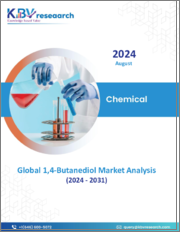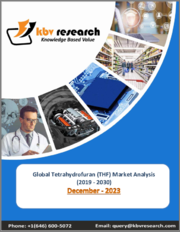
|
시장보고서
상품코드
1752330
세계의 테트라히드로푸란(THF) 시장 : 수요 분석, 지역별, 용도별, 예측(-2034년)Tetrahydrofuran (THF) Market Analysis, By Demand, By Region, By Applications and Forecast Report Till 2034 |
||||||
THF 시장 개요
세계 THF 시장 규모는 2024년 35억 달러를 넘어섰습니다. 향후 10년간 안정적인 성장이 예상되며, 2034년까지 80억 달러 이상에 달할 것으로 예상되며, 연간 5.8%의 성장률을 보일 것으로 예측됩니다. 시장은 주로 용매로서의 용도와 폴리테트라메틸렌에테르글리콜(PTMEG) 생산을 위한 원료로서의 용도의 두 가지 부문으로 나뉘는데, PTMEG 부문은 스판덱스 섬유의 주성분인 이 화합물을 만드는 데 THF가 필수적이기 때문에 시장을 주도하고 있습니다.
스판덱스 외에도 THF는 폴리우레탄, PVC 등 여러 유형의 플라스틱 제조에 사용됩니다. 또한 PTFE와 같은 특수 소재의 생산에도 일조하고 있으며, 셀룰로오스 아세테이트를 만들 때 공동 용매로 사용되기도 합니다. 의약품에서 THF는 다양한 의약품의 유효 성분을 합성하고 정제하는 데 중요한 용매 역할을 합니다.
지역 고찰
2024년 세계 THF 수요는 약 1,500 킬로톤으로 2034년까지 연평균 약 4.5%의 성장이 예상됩니다. 아시아태평양이 전 세계 THF의 70% 이상을 사용하며, 중국에서만 전 세계 소비량의 40% 이상을 차지합니다. 이러한 높은 수요는 특히 아시아 지역의 스판덱스 시장과 폴리우레탄 시장의 급격한 성장에 기인합니다. 북미와 서유럽도 THF 시장에 기여하고 있으며, 특히 폴리우레탄 엘라스토머 생산에 기여하고 있습니다.
주요 THF 제조업체
THF 시장의 주요 제조업체는 BASF SE, Invista, LyondellBasell, Dairen Chemical, Ashland, Nova Molecular Technologies, Mitsubishi Chemical, Sipchem 등입니다.
증가하는 산업 수요
여러 산업 분야에서 THF에 대한 수요가 증가함에 따라 THF 제조업체에게 큰 기회를 제공하고 있으며, THF는 비닐 폴리머 및 합성수지 제조에 널리 사용되며, 아디핀산, 숙신산, 부타디엔, 감마부티로락톤 등 다양한 화학제품 생산의 주원료로 사용됩니다. 주성분으로도 작용합니다. 또한 연료 첨가제, 향수, 살충제에도 적용되고 있습니다.
제약 부문에서 THF는 카르베타펜탄, 리파마이신, 프로게스테론과 같은 호르몬과 같은 화합물을 만드는 데 중요합니다. 또한, 의약품 개발에서 흔히 사용되는 그리냐르 반응이나 수소화 알루미늄 리튬을 이용한 환원 반응 등의 공정에서도 반응매질로 사용됩니다.
건강 및 안전 문제
THF는 다양한 용도로 사용되지만 건강 및 안전 위험이 있습니다. 과도한 노출은 두통, 현기증, 호흡기 염증으로 이어질 수 있으며, THF는 장시간 공기와 접촉하면 과산화물이라는 폭발성 화합물을 생성할 수 있기 때문에 적절한 보관이 필수적입니다. 또한, 인화성이 매우 높고 잠재적 발암물질로 간주되어 안전에 대한 우려가 커지고 있습니다. 이러한 건강 위험은 적절히 관리하지 않으면 향후 몇 년 동안 시장 성장을 둔화시킬 수 있습니다.
세계의 테트라하이드로푸란(THF) 시장에 대해 조사 분석했으며, 시장 역학 및 산업 동향, 각 부문별 수요, 제조업체 프로파일 등의 정보를 전해드립니다.
목차
제1장 서론
제2장 이용 규약
제3장 주석
제4장 시장 요약
- 시장 발전
- 수요 개요
- 산업 구조
- 전략상 문제
- 최종 용도 동향
- 성장 예측
제5장 세계 경제 전망
- GDP와 인구통계
- 금융 정책과 재정 정책
제6장 에너지 전망
- 원유
- 천연가스
- 전기요금
제7장 최종 용도 부문 실적
- 페인트 및 코팅
- 제약
- 전기 및 전자
- 기타
제8장 테트라히드로푸란(THF) 서론과 시장 개요
- 제품 설명
- 등급과 특성
- 원재료
- 제조 공정
- 환경 문제
- 밸류체인
- 용도
제9장 시장 역학과 산업 동향
- 시장 역학
- 성장 촉진요인
- 성장 억제요인
- 기회
- 과제
- 산업 구조
제10장 세계의 테트라히드로푸란(THF) 수요 분석 : 용도별(수량과 금액)(2018년-2034년)
- 전략상 문제
- 수요 분석과 예측(2018년-2034년)
- 수요
- 수요 성장률
- 성장 촉진요인 분석
- 세계의 테트라히드로푸란(THF) 시장 : 용도별
- Polytetramethylene Ether Glycol(PTMEG)
- 용매
- 기타
제11장 수요 분석과 시장 리뷰 : 지역/국가별(수량과 금액)(2018년-2034년)
- 전략상 문제
- 수요 분석과 예측(2018년-2034년)
- 수요
- 수요 성장률
- 테트라히드로푸란(THF) 시장 : 용도별
- 북미
- 미국
- 캐나다
- 멕시코
- 서유럽
- 독일
- 프랑스
- 이탈리아
- 영국
- 스페인
- 기타 서유럽
- 중유럽 및 동유럽
- 러시아
- 폴란드
- 기타 중유럽 및 동유럽
- 아시아태평양
- 중국
- 일본
- 인도
- 한국
- 기타 아시아태평양
- 중남미
- 중동 및 아프리카
제12장 기회 평가
- 시장의 매력 평가
- 전망과 타겟 시장 조사
제13장 전략적 추천과 제안
제14장 가격 분석
- 평균 가격
- 가격 예측
제15장 기업 분석
- 테트라히드로푸란(THF) 제조업체 개요/기업 분석
- 기본 상세
- 본사 및 주요 시장
- 소유
- 기업 재무
- 제조거점
- 세계의 판매
- 총 직원수
- 제품 포트폴리오/서비스/솔루션
- 최근 발전
대상 기업
- BASF SE
- Invista
- LyondellBasell
- Dairen Chemical
- Ashland
- Nova Molecular Technologies
- Mitsubishi Chemical
- Sipchem
- 기타 제조업체
제16장 부록
LSHTetrahydrofuran, commonly known as THF, is a clear, colorless organic liquid with a wide range of industrial uses. It's best known for being a highly effective solvent due to its water solubility and low viscosity. One of its primary uses is as a building block in the production of polymers that are used in coatings, adhesives, and printing inks.
THF is typically produced in three main ways and the most common method, used by companies like Ashland, involves the acid-catalyzed dehydration of 1,4-butanediol. Another method, developed by DuPont, starts with the oxidation of n-butane to create maleic anhydride, which is then converted into THF through catalytic hydrogenation. A third process includes modifying allyl alcohol through hydroformylation and then hydrogenating it to form 1,4-butanediol, which is further processed into THF.
THF Market Overview
The global THF market was valued at more than USD 3.5 billion in 2024. With steady growth projected over the next decade, it's estimated to cross USD 8 billion by 2034, growing at an annual rate of 5.8%. The market is mainly divided into two segments: its use as a solvent and as a raw material for producing polytetramethylene ether glycol (PTMEG). The PTMEG segment leads the market since THF is essential in creating this compound, which is a key ingredient in making spandex fibers.
Besides spandex, THF is used in manufacturing several types of plastics, including polyurethane and PVC. It also plays a role in producing specialty materials like PTFE and is used as a co-solvent in making cellulose acetate. In pharmaceuticals, THF serves as a crucial solvent for synthesizing and purifying active ingredients in various medications.
Regional Insights
In 2024, global demand for THF was about 1,500 kilo tons and is projected to grow by around 4.5% annually through 2034. The Asia Pacific region leads the way, using more than 70% of the world's THF, with China alone accounting for over 40% of global consumption. This high demand is driven by the rapid growth of the spandex and polyurethane markets, especially in Asia. North America and Western Europe also contribute to the THF market, particularly in the production of polyurethane elastomers.
Major THF Manufacturers
Key players in the THF market include BASF SE, Invista, LyondellBasell, Dairen Chemical, Ashland, Nova Molecular Technologies, Mitsubishi Chemical, and Sipchem.
Growing Industrial Demand
The rising demand for THF across multiple industries is creating strong opportunities for its manufacturers. It's widely used in making vinyl polymers and synthetic resins. THF also acts as a key ingredient in producing a range of chemicals including adipic acid, succinic acid, butadiene, and gamma-butyrolactone. It even has applications in fuel additives, perfumes, and pesticides.
In the pharmaceutical sector, THF is crucial in making compounds like carbetapentane, rifamycin, and hormones such as progesterone. It also serves as a reaction medium in processes like the Grignard reaction or reductions using lithium aluminum hydride common in drug development.
Health and Safety Concerns
Despite its many uses, THF poses certain health and safety risks. Overexposure can lead to headaches, dizziness, and irritation of the respiratory tract. When exposed to air over time, THF can form explosive compounds called peroxides, making proper storage essential. It's also highly flammable and is considered a potential carcinogen, which adds to the safety concerns. These health hazards may slow down its market growth in the coming years if not properly managed.
Table of Contents
1. Introduction
2. Terms & Conditions of Use
3. Explanatory Notes
- Market Coverage
- Application
- Regions
- Countries
- Years Considered
- Historical - 2018 - 2023
- Base - 2024
- Forecast Period - 2025 - 2034
- Research Methodology
- Approach
- Research Methodology
- Prismane Consulting Market Models
- Assumptions & Limitations
- Abbreviations & Definitions
- Conversion Factors
- Data Sources
4. Market Synopsis
- Market Evolution
- Demand Overview
- Industry Structure
- Strategic Issues
- End-use Trends
- Growth Forecast
5. Global Economic Outlook
- GDP and Demographics
- Monetary & Fiscal Policies
6. Energy Outlook
- Crude Oil
- Natural Gas
- Electricity Prices
7. End-use Sector Performance
- Paints & Coatings
- Pharmaceutical
- Electrical & Electronics
- Others
8. Introduction to Tetrahydrofuran (THF) and Market Overview
- Product Description
- Grades & Properties
- Raw Material
- Manufacturing Process
- Environmental Issues
- Value Chain
- Applications
9. Market Dynamics and Industry Trends
- Market Dynamics
- Drivers
- Restraints
- Opportunities
- Challenges
- Industry Structure
10. Global Tetrahydrofuran (THF) Demand Analysis By Application (Volume, Value) (2018 - 2034)
- Strategic Issues
- Demand Analysis and Forecast (2018 - 2034)
- Demand
- Demand Growth Rate (%)
- Driving Force Analysis
- Global Tetrahydrofuran (THF) Market, By Application
- Polytetramethylene Ether Glycol (PTMEG)
- Solvent
- Others
11. Demand Analysis and Market Review, By Region, By Country (Volume, Value), (2018 - 2034)
- Strategic Issues
- Demand Analysis and Forecast (2018 - 2034)
- Demand
- Demand Growth Rate (%)
- Tetrahydrofuran (THF) Market, By Application
Note: Demand Analysis has been provided for all major Regions / Countries as mentioned below. The demand (consumption) split by Applicationhas been provided for each of the countries / regions in Volume (Kilo tons) and Value (USD Million).
- North America
- USA
- Canada
- Mexico
- Western Europe
- Germany
- France
- Italy
- United Kingdom
- Spain
- Rest of Western Europe
- Central & Eastern Europe
- Russia
- Poland
- Rest of Central & Eastern Europe
- Asia-Pacific
- China
- Japan
- India
- South Korea
- Rest of Asia-Pacific
- Central & South America
- Middle East & Africa
Note: CAGR will be calculated for all the applications to arrive at the regional / global demand growth for the forecast period (2025 - 2034)
12. Business Opportunity Assessment
- Market Attractiveness Assessment
- Prospective & Target Market Study
13. Strategic Recommendation & Suggestions
14. Pricing Analysis
- Average Prices
- Price Forecast
15. Company Analysis
- Tetrahydrofuran (THF) Manufacturers Profiles/ Company Analysis
- Basic Details
- Headquarter, Key Markets
- Ownership
- Company Financial
- Manufacturing Bases
- Global Turnover
- Total Employee
- Product Portfolio / Services / Solutions
- Recent Developments
Companies Covered -
- BASF SE
- Invista
- LyondellBasell
- Dairen Chemical
- Ashland
- Nova Molecular Technologies
- Mitsubishi Chemical
- Sipchem
- Other Manufacturers
Note: This section includes company information, company financials, manufacturing bases and operating regions. Company financials have been mentioned only for those companies where financials were available in SEC Filings, annual reports, or company websites. All the reported financials in this report are in U.S. Dollars. Financials reported in other currencies have been converted using average currency conversion rates. Company profiles may include manufacturers, suppliers, and distributors.
16. Appendices
- Target Markets
- Demand - Regions
- Demand - Countries

















